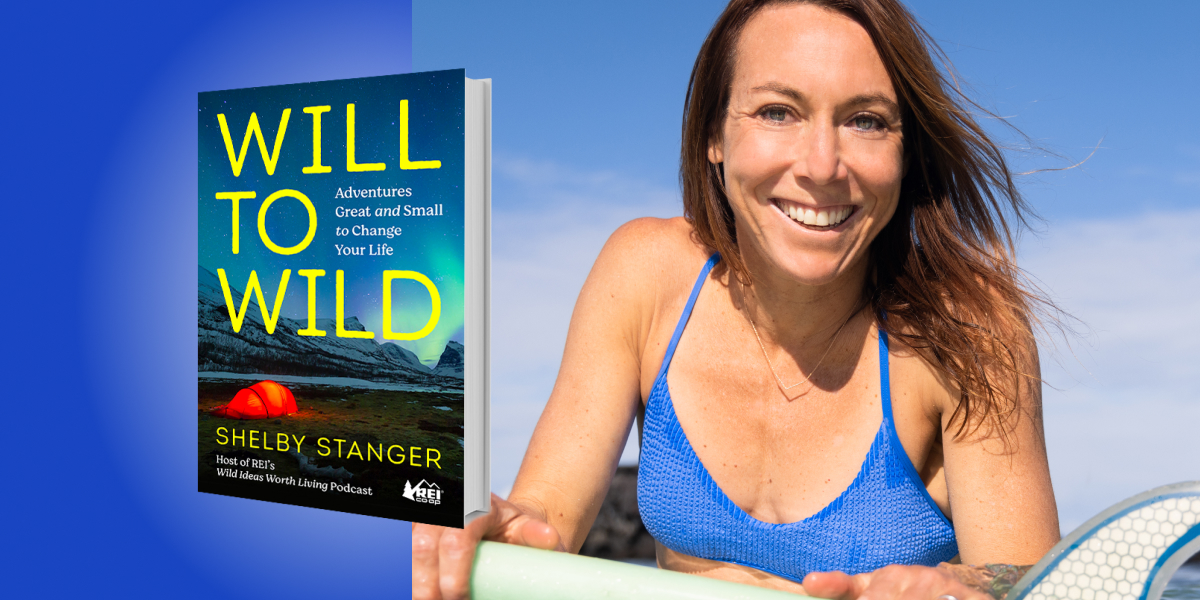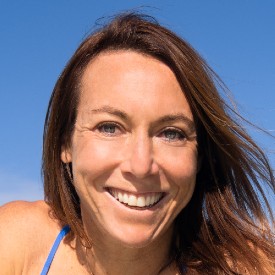Shelby Stanger is the host and creator of the hit podcast, Wild Ideas Worth Living, an REI Co-Op Studios production. Over the years, her work has appeared everywhere from Outside Magazine to ESPN, and she has spoken to organizations like The Girl Scouts of America, NPR, and Creative Mornings.
Below, Shelby shares 5 key insights from her new book, Will to Wild: Adventures Great and Small to Change Your Life. Listen to the audio version—read by Shelby herself—in the Next Big Idea App.

1. A little adventure can go a long way.
I’ve been fascinated by adventure and its profound effects ever since I was a kid. I didn’t grow up outdoorsy, but as a teen through my twenties, I taught surf lessons. Women would come for a weekend or week-long clinic, learn to ride a few waves, and shortly after, one of them would call me saying they quit their job, ended a relationship that was no longer serving them, or that they were moving across the country to a place with a beach. I was so intrigued by this phenomenon, I made it my life’s work to study people who chased the will to wild. I started first as an adventure journalist, then as an adventure podcaster, and most recently as an author.
Pursuing your own will to wild—or wild ideas—could have a profound effect on someone’s mindset and life. It can be something as simple as signing up for a surf lesson, going for big hike, or making a commitment to watch the sunrise every day for a month. Hundreds of people have done just this—from a mom who became an ice climbing guide at age 55, to a retired sales exec who biked from Alaska to Mexico, to a couple who skied to the South Pole while the wife was going through menopause, to even someone who just took up birdwatching. There are a lot of things you can do to change your life, but one of the most fun and exciting ways is to have an adventure.
First, nature is healing. In nature, our blood pressure often decreases, our nervous systems relax, and we can often make decisions more easily. A 2019 study showed that even as little as 20 minutes of nature a day can reduce the stress hormone, cortisol.
Being in nature also provides the chance to experience awe and flow. Think about the times you have seen a magical sunset, a giant redwood tree, a dolphin leap in the ocean, or a bird swoop down and grab a worm or a snake. Chances are it stopped you in your tracks. You could have been having a bad day before. But when you see something like that, it’s a pattern interrupter. You often soften, and become kinder. When you look up at a sky of stars, or out at a grand horizon from a mountaintop, you often realize how small we are, yet how much more connected we are to each other.
“Nature is healing.”
Adventuring in nature also forces us to be present. When riding a wave or hiking near a ledge, you have to slow down and pay attention, or you’ll fall. Being so present and surrounded by so much beauty can be cathartic. Nature doesn’t judge who you are, how much money you have, or what you look like. She also provides a lot of great lessons. You can’t have rainbows without rain.
Lastly, adventuring in nature allows us to build courage. Surf a wave that scares you, climb a steep mountain, go on your first hike, or just try snowboarding or skiing for the first time, and after, you can’t help but feel more badass. That badassery will carry over to the rest of your life.
2. Have a strong why.
Wild ideas are scary. Having a strong why will keep you on the trail, even when you want to turn back. Most of all, having a strong why will shush the naysayers and doubters, including the biggest ones of all, the ones in your own head.
Most people have a wild idea they want to pursue—an idea that keeps them awake at night and scares them, but that they know will propel their life forward in a positive way. Dr. Edith Eger is a Holocaust survivor and the oldest guest on my podcast. She was 91 when I talked with her, and she had just published her first book, followed by another two years later. She was friends with Viktor Frankl, another Holocaust survivor. Frankl was a psychiatrist and the author who said the famous line, “Those who have a why to live can bear with any how.” Edith’s philosophy was also that if you have a strong why, you will find a way to do the thing you most want to do. Edith’s why for surviving the Holocaust was just to live and to see her family again.
Your why in pursuing a wild idea might be because you think a wild idea will improve your health, your relationship with your family, yourself, or maybe it will just bring you a lot of joy. A why can also be because not doing so will bring you too much pain. Even if your why is just because it brings you immense joy, that’s a great why. As Edith taught me, “Self-love is self-care. It’s not narcissistic.”
If you need help finding your wild idea and your why behind it, ask yourself what you would do if you won the lottery tomorrow, or if you were to give a TED talk, what gift you have that you can share that might help others.
“Having a strong why will keep you on the trail.”
When your why is attached to altruism, the desire to do something to help others, it’s like adding a super-booster. Your own wild idea might even be an act of altruism itself, paving a path for someone else, a group, or even an entire community. Once you have your why, it will be much easier to stay the course, cull the doubt, and to keep going, even when things get challenging.
3. Map your trail, but start as soon as you can.
When it comes to wild ideas, if it takes too long to plan or there’s too much to do, you can get overwhelmed and quit. A sailor told me it best: “You can either untie the dock lines or not,” he said. “You can let yourself be unready forever if you let yourself be.” Eventually, the sailor and his wife realized they could finish some of their sailing projects at sea after they left the safe harbor.
Obviously, you want to plan and prep for anything that can go wrong as best as possible, especially when your wild idea involves risk. The riskier the idea, the more adept you will need to be at handling what to do when something goes wrong, which will likely happen on any adventure.
My advice is to go to people who have done something similar and learn from them. Eventually, you just have to set sail, put your feet on the dirt trail, and go. There’s always more to learn and do. One thing that helps: put down a deposit on that campsite, park permit, basic wilderness first aid class, or plane ticket. If you have some skin in the game, you are less likely to back out. A deadline and some knowledge will encourage you to start. Even if it costs a little money, adventure doesn’t have to be expensive, and investing in yourself is the best investment you can make.
4. Use humor to deflate fear.
When it comes to adventure it’s not if but when something goes wrong. You can moan or get upset, but that wastes energy. Big wave surfers and hardcore rock climbers are known for immense amounts of smack-talking, even in perilous situations. Even Free Solo Oscar-winning Rock Climber Alex Honnold likes to crack jokes when it gets tense with his climbing partner.
“Some of the biggest adventure mishaps make for the funniest stories.”
When I taught surf lessons, the most athletic students would sometimes get in their heads when they were not excelling immediately. Other students would start beating themselves up if they were scared of going out in bigger surf, myself included. A good joke, and helping them take themselves less seriously, often helped them loosen up, get out there, and ride the waves. If you do get into a serious jam where you can’t extract yourself, get help. Then, laugh about it. Some of the biggest adventure mishaps make for the funniest stories—often much later.
5. Take the scenic route and give yourself grace at the finish line.
Unless you are going for an FKT (Fastest Known Time), take the slower scenic route. That extra time to go off the side trail to get to the epic vista or that awesome waterfall is almost always worth it. Some of the best adventures happen when you go off the trail, say yes to a new friend’s request to cook a campfire dinner, or take the route that leads you to an empty, stunning mountainside lake. Many adventures have told me that’s also how they met their best friend, their soul mate, or life partner. I met my own while surfing in Costa Rica.
When you finish your epic adventure, even if it’s small, give yourself grace at the finish line and try to celebrate along the way. Many adventure stories glorify the finish line, but re-entry can take some getting used to. A guy I knew puked the minute he returned to the city after a long time in the wilderness. The smell was just too much. Some people experience some grief and fatigue, especially if the adventure was truly grand. Take your time, plan mini-adventures when you get back to your daily life, be kind, and do your best to carry the spirit of adventure back into your everyday life. That’s what the will to wild is about after all. It’s about kindness. It’s about living with intention and making the choice to have a deeper relationship with nature, however you can.
To listen to the audio version read by author Shelby Stanger, download the Next Big Idea App today:































